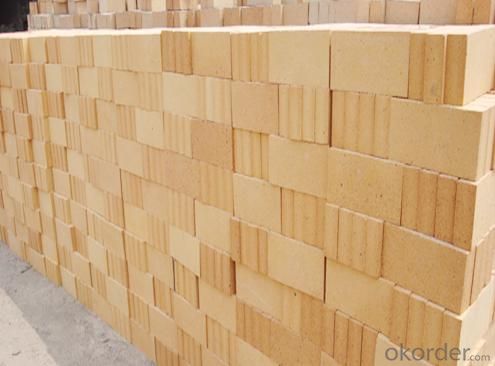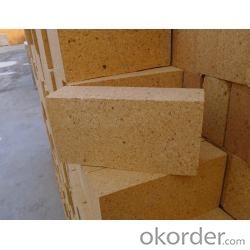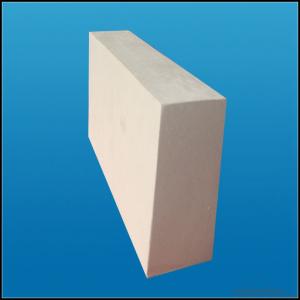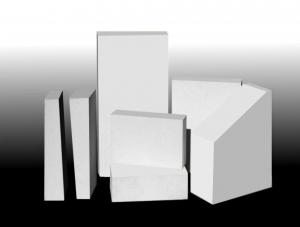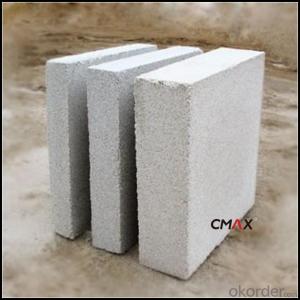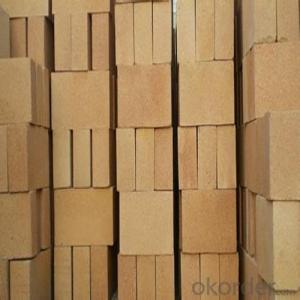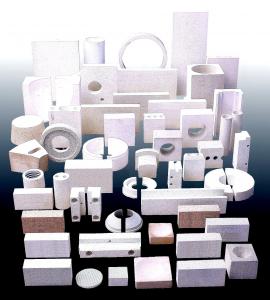SK-34 Insulating Fire Brick
- Loading Port:
- China Main Port
- Payment Terms:
- TT OR LC
- Min Order Qty:
- -
- Supply Capability:
- -
OKorder Service Pledge
OKorder Financial Service
You Might Also Like
Specifications
Fire brick1.ISO 9001 approved,
2.With high quality and competitive price,
3.Standard and special shape.
Fire-clay refractory brick.
1. N-1
AL2O3 (%)>42
Refractoriness >1750
Refractoriness under load KD>1400
Permanent linear change onreheating
1500*2h
1450*2h
1400*2h:+0.1; -0.4
Apparent Porosity(%)<22
Cold crushing strength (Mpa)>29.4
2. N-2a
AL2O3 (%)>40
Refractoriness >1730
Refractoriness under load KD>1350
Permanent linear change onreheating
1500*2h
1450*2h
1400*2h:+0.1; -0.5
Apparent Porosity(%)<24
Cold crushing strength (Mpa)>24.5
High-alumina refractory brick
1. LZ-75
AL2O3 (%)>75
Refractoriness>1790
Refractoriness under load KD>1520
Permanent linear change onreheating
1500*2h:+0.1; -0.4
1450*2h
1400*2h
Apparent Porosity(%)<23
Cold crushing strength (Mpa)>53.9
2. LZ-65
AL2O3 (%)>65
Refractoriness >1790
Refractoriness under load KD>1500
Permanent linear change onreheating
1500*2h:+0.1; -0.4
1450*2h
1400*2h
Apparent Porosity(%)<23
Cold crushing strength (Mpa)>49
3.LZ-55
AL2O3 (%)>55
Refractoriness >1770
Refractoriness under load KD>1470
Permanent linear change onreheating
1500*2h:+0.1; -0.4
1450*2h
1400*2h
Apparent Porosity(%)<22
Cold crushing strength (Mpa)>44.1
4.LZ-48
AL2O3 (%)>48
Refractoriness >1750
Refractoriness under load KD>1420
Permanent linear change onreheating
1500*2h
1450*2h:+0.1; -0.4
1400*2h
Apparent Porosity(%)<22
Cold crushing strength (Mpa)>39.2
Fire clay brick SK-32 | |
Item | Standard |
AI2O3(%) | 30 |
Fe2O3 (%) | 3.5 |
Refractoriness (SK) | 32 |
Refractoriness under load, 0.2MPa, Ta, (°C) | 1300 |
Porosity (%) | 22-26 |
Bulk density (g/cm³) | 2.05 |
Cold crushing strength (MPa) | 25 |
Thermal expansion at 1000°C (%) | 0.6 |
Fire clay brick SK-34 | |
Item | Standard |
AI2O3(%) | 38 |
Fe2O3 (%) | 2.5 |
Refractoriness (SK) | 34 |
Refractoriness under load, 0.2MPa, Ta, (°C) | 1350 |
Porosity (%) | 19-23 |
Bulk density (g/cm³) | 2.10-2.15 |
Cold crushing strength (MPa) | 25 |
Thermal expansion at 1000°C (%) | 0.6 |
Fire clay brick SK-36 | |
Item | Standard |
AI2O3(%) | 50 |
Fe2O3 (%) | 2 |
Refractoriness (SK) | 36 |
Refractoriness under load, 0.2MPa, Ta, (°C) | 1450 |
Porosity (%) | 20-24 |
Bulk density (g/cm³) | 2.30-2.40 |
Cold crushing strength (MPa) | 45 |
Thermal expansion at 1000°C (%) | 0.3 |
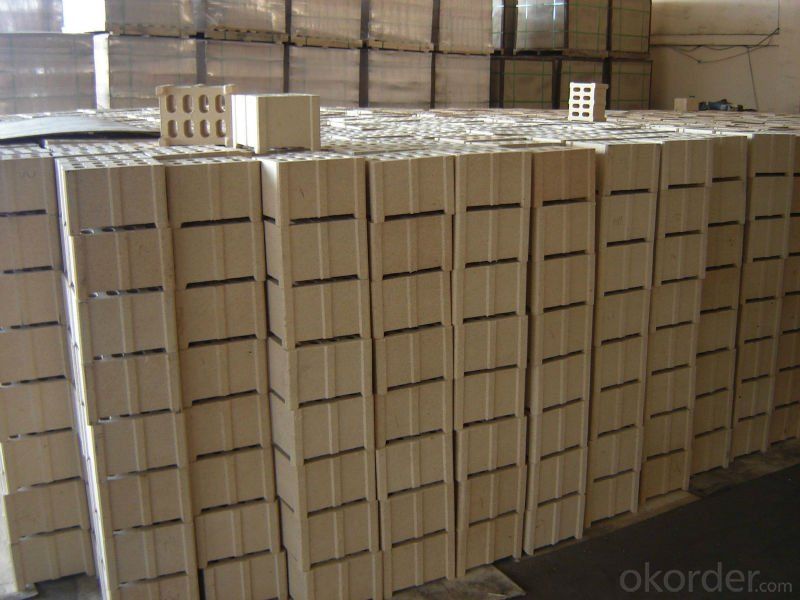
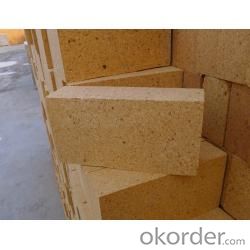
- Q: Can insulating fire bricks be used in the construction of boilers for power plants?
- Yes, insulating fire bricks can be used in the construction of boilers for power plants. These bricks have excellent insulating properties, which help to retain heat and increase energy efficiency in the boilers. Additionally, their lightweight nature reduces the overall weight of the construction, making them a suitable choice for power plant boilers.
- Q: Can insulating fire bricks be used in refractory lining for steelmaking?
- Yes, insulating fire bricks can be used in refractory lining for steelmaking. They are effective in providing insulation and thermal stability, helping to maintain high temperatures and protect the surrounding structures. Additionally, insulating fire bricks have low thermal conductivity and are lightweight, making them suitable for steelmaking processes that require heat retention and energy efficiency.
- Q: Are insulating fire bricks resistant to thermal fatigue?
- Insulating fire bricks exhibit remarkable resistance to thermal fatigue. These bricks are purposefully engineered to endure elevated temperatures and thermal cycling without experiencing any cracks or fractures. Composed of refractory materials with exceptional thermal shock resistance, they possess the ability to expand and contract without suffering significant harm. This capacity to withstand thermal fatigue renders insulating fire bricks highly suitable for applications involving extreme temperature fluctuations, such as kilns, furnaces, and other environments with high temperatures.
- Q: Are insulating fire bricks resistant to erosion from flowing gases or liquids?
- Yes, insulating fire bricks are generally resistant to erosion from flowing gases or liquids. Insulating fire bricks are designed to have good thermal insulation properties and to withstand high temperatures, making them suitable for various industrial applications. These bricks are made from lightweight refractory materials that have low porosity, which helps to minimize the penetration of gases and liquids. Additionally, insulating fire bricks are often chemically inert, which further enhances their resistance to erosion. However, it is important to note that the specific resistance of insulating fire bricks to erosion may vary depending on the composition and manufacturing process of the brick, as well as the nature and intensity of the flowing gases or liquids. Therefore, it is advisable to consult with the manufacturer or a qualified professional to determine the suitability of insulating fire bricks for a specific application.
- Q: Can insulating fire bricks be used in the construction of pottery slab rollers?
- Yes, insulating fire bricks can be used in the construction of pottery slab rollers. These bricks can provide thermal insulation and withstand high temperatures, making them suitable for pottery kilns and other heat-intensive applications like slab rollers.
- Q: Can insulating fire bricks be custom-made?
- Yes, insulating fire bricks can be custom-made to meet specific requirements and dimensions.
- Q: Can insulating fire bricks be used in the construction of foundry furnaces?
- Yes, insulating fire bricks can be used in the construction of foundry furnaces. Insulating fire bricks are made from lightweight materials that have high insulating properties, such as ceramic fibers, vermiculite, or perlite. These bricks are designed to withstand high temperatures, making them suitable for use in foundry furnaces. Foundry furnaces require materials that can withstand the extreme heat generated during the melting of metals. Insulating fire bricks have a high resistance to heat transfer, which helps to minimize heat loss in the furnace. This makes them an excellent choice for insulating the walls and floor of the furnace, as they can help to improve energy efficiency and reduce fuel consumption. Additionally, insulating fire bricks are lightweight, which makes them easier to handle and install in the construction of the furnace. Their lightweight nature also reduces the overall weight of the furnace structure, making it more portable and easier to move if needed. Overall, insulating fire bricks are a suitable choice for the construction of foundry furnaces due to their high insulating properties, resistance to heat, and lightweight nature. They can help improve the efficiency and performance of the furnace while withstanding the extreme temperatures required for metal melting.
- Q: Can insulating fire bricks be used in the construction of combustion chambers for rocket engines?
- Insulating fire bricks are capable of being utilized in the construction of rocket engine combustion chambers. They are specifically engineered to endure elevated temperatures and provide exceptional thermal insulation. This makes them an ideal option for situations involving extreme heat, such as rocket engine combustion chambers. The main purpose of insulating fire bricks in a rocket engine's combustion chamber is to shield the surrounding structure from the intense heat generated during combustion. By offering insulation, these bricks aid in minimizing the transfer of heat to the outer walls of the combustion chamber, thus averting damage and ensuring the chamber's structural integrity. Moreover, insulating fire bricks possess a lightweight composition and exhibit low thermal conductivity, enabling them to effectively retain heat within the combustion chamber. This characteristic is vital for maintaining optimal combustion efficiency and enhancing rocket performance. In addition to their thermal properties, insulating fire bricks are recognized for their durability and resistance to thermal shock. This attribute is particularly valuable in rocket engine applications where rapid temperature fluctuations can occur, such as during ignition or shutdown sequences. The ability of insulating fire bricks to endure such thermal stresses is imperative for the dependable operation and extended lifespan of the combustion chamber. Overall, insulating fire bricks are a suitable choice for constructing combustion chambers in rocket engines due to their ability to withstand high temperatures, provide thermal insulation, possess a lightweight nature, and exhibit durability.
- Q: Can insulating fire bricks be used in high-temperature insulation blankets for aerospace applications?
- Insulating fire bricks are typically not used in high-temperature insulation blankets for aerospace applications. This is because insulating fire bricks are solid and rigid, which makes them unsuitable for flexible and conformable insulation applications like insulation blankets. Aerospace applications require insulation materials that can be easily molded and shaped to fit complex geometries, such as the insulation blankets used to protect critical components from extreme heat and temperature fluctuations. Instead, high-temperature insulation blankets for aerospace applications are typically made from flexible and lightweight materials like ceramic fiber or silica fiber. These materials offer excellent thermal insulation properties while also providing flexibility and conformability. They can be easily wrapped around or applied to various components, ensuring effective heat insulation and protection. Furthermore, insulation blankets used in aerospace applications are subjected to stringent requirements such as low outgassing, high thermal stability, and resistance to vibration and mechanical stress. Insulating fire bricks may not meet these specific requirements and may not be able to withstand the extreme conditions experienced in aerospace environments. In summary, while insulating fire bricks are excellent for certain high-temperature insulation applications, they are not suitable for use in aerospace insulation blankets. Aerospace applications require flexible, lightweight, and high-performance insulation materials that can conform to complex shapes and withstand the unique challenges of the aerospace industry.
- Q: Can insulating fire bricks be used in the construction of smelting furnaces?
- Yes, insulating fire bricks can be used in the construction of smelting furnaces. These bricks are designed to withstand high temperatures and provide excellent insulation, making them suitable for smelting furnaces where heat retention is crucial. They help to minimize heat loss and maintain the desired temperature within the furnace, thus improving energy efficiency and overall performance.
Send your message to us
SK-34 Insulating Fire Brick
- Loading Port:
- China Main Port
- Payment Terms:
- TT OR LC
- Min Order Qty:
- -
- Supply Capability:
- -
OKorder Service Pledge
OKorder Financial Service
Similar products
Hot products
Hot Searches
Related keywords



